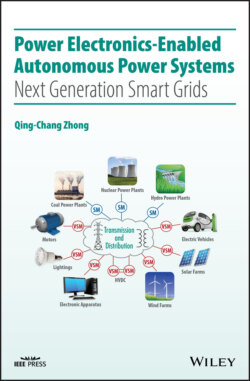Читать книгу Power Electronics-Enabled Autonomous Power Systems - Qing-Chang Zhong - Страница 26
2.2 SYNDEM Rule of Law – Synchronization Mechanism of Synchronous Machines
ОглавлениеThere are different power plants, such as coal‐fired, nuclear, and hydro power plants, in existing power systems. However, electricity generation is dominated by only one type of electrical machine – synchronous machines. The reason why the industry has decided to adopt synchronous machines while there are different types of electric machines is because synchronous machines have an inherent synchronization capability. This can be understood by looking at the mathematical model of synchronous machines.
A synchronous generator, which is a synchronous machine operated as a generator, is governed by the swing equation
(2.1)
where is the rotor angle; is the angular speed of the machine; is the mechanical torque applied to the rotor; is the moment of inertia of all the parts rotating with the rotor; is the friction coefficient; and is the electromagnetic torque
(2.2)
Here, is the number of pole pairs of the magnetic field and can be assumed to be 1 without loss of generality; is the stator current; is the field excitation current; is the maximum mutual inductance between the stator windings and the field winding; and denotes the conventional inner product. The vectors and are defined, respectively, as
The three‐phase generated voltage and the reactive power are, respectively,
(2.3)
(2.4)
with being the amplitude of the voltage. Assume that the terminal voltage is . Then the stator current is
(2.5)
where is the impedance of the stator windings. Note that , and in (2.5) are the Laplace transforms of the corresponding signals. It should be clear whether a signal is in the time domain or in the frequency domain from the context.
The mathematical model of a synchronous machine described in (2.1)–(2.5) for the single‐phase case is shown in Figure 2.2, after adding one integrator to zero the output of the block and two low‐pass filters to remove the ripples in the torque and the reactive power. This is actually an enhanced phase‐locked loop called the sinusoid‐locked loop (Zhong and Hornik 2013; Zhong and Nguyen 2012). The core of the upper part of Figure 2.2 represents the swing (equation 2.1) and the torque (2.2), which is a conventional phase‐locked loop that can synchronize the frequency and the phase with those of the terminal voltage. The lower part is an amplitude channel to synchronize the amplitude of with the terminal voltage. In the steady state, when and the reference for is 0, there are and , which means and , achieving frequency, phase and amplitude synchronization. In other words, synchronous machines have the inherent mechanism of synchronization, which allows them to synchronize with each other or the grid autonomously.
Figure 2.2 The sinusoid‐locked loop (SLL) that explains the inherent synchronization mechanism of a synchronous machine.
The synchronization mechanism of synchronous machines is the mechanism that has underpinned and facilitated the organic growth and stable operation of power systems for over 100 years. In order to guarantee the compatibility of millions of heterogeneous players with the grid, this mechanism should be followed and adopted as the rule of law for SYNDEM smart grids. In this way, the synchronization mechanism also guarantees that all individuals could synchronize with each other to reach a consensus, i.e. for the voltage and the frequency to stay around the rated values, e.g. 230 V voltage and 50 Hz frequency in Europe and 120V voltage and 60 Hz frequency in the US, so that the system stability is maintained. Moreover, this can be achieved without relying on a dedicated communication network. The function of communication is achieved based on the inherent synchronization mechanism of synchronous machines through the electrical system. As a result, the communication system in a SYNDEM smart grid can be released from low‐level controls and adopted to focus on high‐level functions, e.g. information monitoring, management, electricity market, etc.
As a matter of fact, the tendency to synchronize, or to act simultaneously, is probably the most mysterious and pervasive phenomenon in nature, from orchestras to GPS, from pacemakers to superconductors, from biological systems to communication networks (Strogatz, 2004). The observations that organisms adapt their physiology and behavior to the time of the day in a circadian fashion have been documented for a long time. For example, Chuang Tzu, who was an influential Chinese philosopher, a follower and developer of Taoism in the 4th century BC, wrote in his book Chuang Tzu (Chuang Tzu 2016) “to go to work at sunrise and go to rest at sunset,” pointing out the importance of synchronizing human activities with the sun. The synchronization phenomenon has intrigued some of the most brilliant minds of the 20th century, including Albert Einstein, Richard Feynman, and Norbert Wiener. In 2017, the Nobel Prize in Physiology or Medicine was awarded to Jeffrey C. Hall, Michael Rosbash and Michael W. Young for their discoveries of molecular mechanisms that control circadian rhythms (Nobelprize.org 2017). They uncovered the internal clocks that synchronize cellular metabolism and organismal behavior to the light/dark cycle to generate biological rhythms with 24 h periodicity.
Hence, adopting the synchronization mechanism of synchronous machines as the rule of law to govern SYNDEM smart grids is probably also the most natural option.
